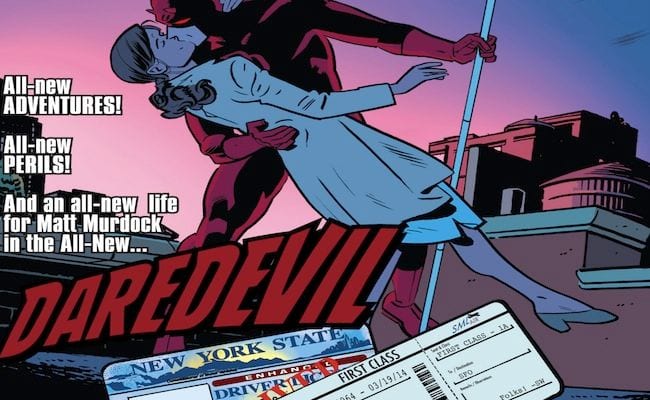
It’s always bittersweet when an acclaimed run comes to an end. While serialized superhero comics are all premised on the notion of ‘to be continued,’ some creators can just be so solid, so on, so, to quote former Illinois governor Rod Blagojevich, “fucking golden”, that their tenure ending really feels like something most characters never get: a conclusion.
Daredevil #36, by Mark Waid and Chris Samnee, is an ending, of sorts. However, it feels far more like the beginning of something new. And it is. This might be the conclusion to this current volume but Waid and Samnee will be back in no time flat. A new issue #1 is imminent. Instead of a farewell, it’s an ‘I’ll see you later.’
Due to the fallout from yet another outing of his secret identity, Matt Murdock needs to up sticks. Waid effectively wraps up many of the dangling threads twisting through the series for a number of months with his customary snappy pace. Samnee, of course, crafts page after page of energetic, lively art, a true treat to behold that tells the story while being just so pleasurable to look at. Viewing his work is like a full body massage for the eyes.
The conceit of another unmasking is an interesting choice. Waid’s run has always felt like a refutation to the past three decades of Daredevil stories. Ever since Frank Miller shattered expectations of what this character could, or should, do, writers have more or less held to this schema. Costumed noir: yes. Swashbuckling: no. Daredevil became the ultimate underdog, less of a hero and more of a punching bag that kept getting back up.
From the start, Waid’s work has been a pushback. From writing a smiling Daredevil smooching a mafia bride in issue #1, to this issue’s final scene of an outed Murdock sweeping his gal-pal off her feet, he has worked hard to show that a mature superhero comic doesn’t necessarily need to be a dark one. It’s the old grim-and-gritty saw and Waid looks that tradition squarely in the eyes, forcing it to back down.

The exposure of the Matt Murdock/Daredevil identity has always been a gateway to tragedy or a defeat. Miller famously used it in the essential story arc “Born Again,” breaking the character into bits while both Brian Michael Bendis and Ed Brubaker’s lengthy runs dealt with this same issue, the former handling a public reveal and the latter detailing the damage control.
Here, in issue #36, Waid takes that hallowed trope and turns it around, transforming it into a path to victory. The Daredevil-as-punching bag tradition has been broken. Murdock has agency when it comes to declaring his identity. He self-identifies, outing himself. Instead of reacting, he is now in the driver seat. In terms of identity politics, this is a very modern, progressive take. You are, or should be, in control of your identity, whether it be sexual, racial, or, in this case, costumed.
Perhaps that’s what has made Waid, et al’s. run with the character so refreshing. Perhaps that’s why this issue feels so earned and exciting. While Frank Miller is one of the creators responsible for making comics modern, it is a modernity decades old. Waid and Samnee, arguably, have made Daredevil modern once more, updating the character’s sensibilities that feel far more in touch with contemporary America.
It’s no surprise that Daredevil is packing up for San Francisco, a city held up as a liberal icon that is also wracked with an accelerating wealth gap, embodied by the Google bus, gentrification, and the tech boom. Although this excellent issue won’t offer readers much closure, it never was designed for that. This is the start of something new, yet familiar, in the way all superhero comics thrive on nostalgia, a through-line that has always been present in Waid’s run and on full display in Daredevil #36.


![Call for Papers: All Things Reconsidered [MUSIC] May-August 2024](https://www.popmatters.com/wp-content/uploads/2024/04/all-things-reconsidered-call-music-may-2024-720x380.jpg)



